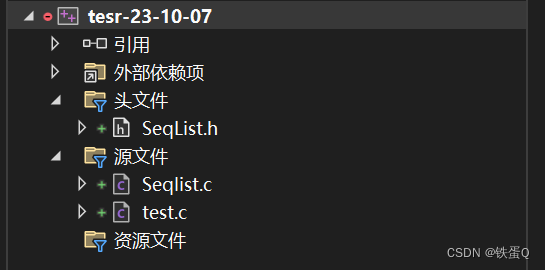-
c语言练习题82:顺序表的使用
顺序表的使用
1、顺序表的概念及结构
线性表(linear list)是n个具有相同特性的数据元素的有限序列。 线性表是⼀种在实际中⼴泛使 ⽤的数据结构,常⻅的线性表:顺序表、链表、栈、队列、字符串...
线性表在逻辑上是线性结构,也就说是连续的⼀条直线。但是在物理结构上并不⼀定是连续的, 线性表在物理上存储时,通常以数组和链式结构的形式存储。
顺序表和数组的区别
◦ 顺序表的底层结构是数组,对数组的封装,实现了常⽤的增删改查等接⼝
• 顺序表分类
◦ 静态顺序表 概念:使⽤定⻓数组存储元素

◦ 动态顺序表

2、动态顺序表的实现


Seqlist.c
- #define _CRT_SECURE_NO_WARNINGS
- #include"SeqList.h"
- void SLInit(SL* ps) {
- ps->a = NULL;
- ps->capacity = ps->size = 0;//也可在初始化时开辟空间
- }
- void SLDestory(SL* ps) {
- if (ps->a) {
- free(ps->a);
- }
- ps->a = NULL;
- ps->capacity = ps->size = 0;
- }
- void SLCheckCapacity(SL* ps) {
- //空间足够直接尾插
- //空间不够则进行扩容
- if (ps->size == ps->capacity) {
- //空间不够则进行扩容(relloc申请失败返回空指针)
- int newCapacity = ps->capacity == 0 ? 4 : ps->capacity * 2;
- SLDataType* tmp = (SLDataType*)realloc(ps->a, newCapacity * 2 * sizeof(SLDataType));
- if (tmp == NULL) {
- perror("relloc fail\n");
- return 1;
- }
- ps->a = tmp;
- ps->capacity = newCapacity;
- }
- }
- void SLPushBack(SL* ps, SLDataType x){
- assert(ps != NULL);
- //空间足够直接尾插
- //空间不够则进行扩容(relloc申请失败返回空指针)
- SLCheckCapacity(ps);
- //直接插入数据
- ps->a[ps->size] = x;//ps->a[ps->size++] = x;
- ps->size++;
- }
- void SLPushFront(SL* ps, SLDataType x) {
- assert(ps);
- //判断空间是否足够不够则扩容
- SLCheckCapacity(ps);
- for (size_t i = ps->size; i > 0; i--) {
- ps->a[i] = ps->a[i - 1];
- }
- ps->a[0] = x;
- ps->size++;
- }
- void SLPopBack(SL* ps) {
- assert(ps);
- assert(!SLIsEmpty(ps));//assert(ps->size)也可以
- //ps->a[ps->size - 1] = 0;//(可有可无)
- ps->size--;//size最初为0,为0则不能减减
- }
- void SLPopFront(SL* ps, SLDataType x) {
- assert(ps);
- assert(!SLIsEmpty(ps));//进行判空操作,不为空才能继续
- //让后面数据往前挪一位
- for (size_t i = 0; i < ps->size-1; i++) {//size_t为无符号整形
- //最后一次进来i为ps->size-2
- ps->a[i] = ps->a[i + 1];
- }
- ps->size--;
- }
- void SLPrint(SL* ps) {
- for (size_t i = 0; i < ps->size; i++) {
- printf("%d ", ps->a[i]);
- }
- printf("\n");
- }
- bool SLIsEmpty(SL* ps) {
- assert(ps);
- return ps->size == 0;//当前数据表有效数据位0,则当前数据表为空
- }
- //在指定位置之前插入数据
- void SLInsert(SL* ps, int pos, SLDataType x) {
- assert(ps);
- //对pos加以限制
- assert(pos >= 0 && pos <= ps->size);
- //扩容
- SLCheckCapacity(ps);
- //把pos位置及以后的数据往后挪动一位
- //循环里i的初始值可以为size或size-1k,但不同的初始值对应不同的结束条件
- /*for (size_t i = ps->size; i > pos; i--) {
- ps->a[i] = ps->a[i - 1];
- }*/
- for (size_t i = ps->size-1; i > pos-1; i--) {
- ps->a[i+1] = ps->a[i];
- }
- ps->a[pos] = x;
- ps->size++;
- }
- //删除指定位置的数据
- void SLErase(SL* ps, int pos) {
- assert(ps);
- assert(!SLIsEmpty(ps));//进行判空操作,不为空才能继续
- //对pos加以限制
- assert(pos >= 0 && pos <= ps->size);
- for (int i = pos; i < ps->size - 1; i++) {
- //最后一次进来的i的数据为ps->size - 2
- ps->a[i] = ps->a[i + 1];
- }
- ps->size--;
- }
- bool SLFind(SL* ps, SLDataType x) {
- assert(ps);
- for (int i = 0; i < ps->size; i++) {
- if (ps->a[i] == x) {
- //找到了
- return true;
- }
- }
- return false;
- }
test.c
- #define _CRT_SECURE_NO_WARNINGS
- #include"SeqList.h"
- void SLtest() {
- SL sl;
- SLInit(&sl);
- //尾部插入
- SLPushBack(&sl, 1);
- SLPushBack(&sl, 2);
- SLPushBack(&sl, 3);
- SLPushBack(&sl, 4);
- SLPrint(&sl);
- //头部插入
- SLPushFront(&sl, 5);
- SLPushFront(&sl, 6);
- SLPushFront(&sl, 7);
- SLPrint(&sl);
- SLPopBack(&sl);
- SLPrint(&sl);
- SLPopBack(&sl);
- SLPrint(&sl);
- SLDestory(&sl);
- }
- void SLtest02() {
- SL sl;
- SLInit(&sl);
- //尾部插入
- SLPushBack(&sl, 1);
- SLPushBack(&sl, 2);
- SLPushBack(&sl, 3);
- SLPushBack(&sl, 4);
- SLPrint(&sl);
- 头删
- //SLPopFront(&sl);
- //SLPrint(&sl);
- //SLPopFront(&sl);
- //SLPrint(&sl);
- //SLDestory(&sl);
- //在指定位置之前插入数据
- /*SLInsert(&sl, 1, 11);
- SLPrint(&sl);
- SLDestory(&sl);*/
- 删除指定位置的数据
- //SLErase(&sl, 0);
- //SLPrint(&sl);
- //SLErase(&sl, sl.size-1);
- //SLPrint(&sl);
- //
- bool findRet=SLFind(&sl, 3);
- if (findRet) {
- printf("找到了\n");
- }
- else {
- printf("没有找到!\n");
- }
- SLDestory(&sl);
- }
- int main() {
- //SLtest();
- SLtest02();
- return 0;
- }
Seqlist.h
- #define _CRT_SECURE_NO_WARNINGS
- #include
- #include
- #include
- #include
- typedef int SLDataType;
- typedef struct SeqList
- {
- SLDataType* a;
- int size;//顺序表中有效的数据格式
- int capacity;//顺序表当前的空间大小
- }SL;
- //typedef struct SeqList SL(即为)
- //对顺序表进行初始化
- void SLInit(SL* ps);
- //对顺序表进行销毁
- void SLDestory(SL* ps);
- //尾部插入
- void SLPushBack(SL* ps, SLDataType x);
- //头部插入
- void SLPushFront(SL* ps, SLDataType x);
- //尾部删除
- void SLPopBack(SL* ps);
- //头部删除
- void SLPopFront(SL* ps);
- //打印
- void SLPrint(SL* ps);
- //判断顺序表是否位空
- bool SLIsEmpty(SL* ps);
- //在任意位置插入删除
- //在指定位置之前插入数据
- void SLInsert(SL* ps, int pos, SLDataType x);
- //删除指定位置的数据
- void SLErase(SL* ps, int pos);
- bool SLFind(SL* ps, SLDataType x);
- //判断空间是否足够,不够则进行扩容
- void SLCheckCapacity(SL* ps);
-
相关阅读:
四、卷积神经网络(Convolution Neural Networks)
保持数据库唯一的三种方式
YOLOv5识别图像内苹果和香蕉
(附源码)计算机毕业设计 图书管理系统
python之列表介绍
PMP_第4章章节试题
用户登录Demo
腾讯云服务器2核4G、4核8G、8核16G、16核32G配置报价表出炉
给博客园的寄语
LInux本地连接超时ip未显示
- 原文地址:https://blog.csdn.net/2301_77479435/article/details/133708406
